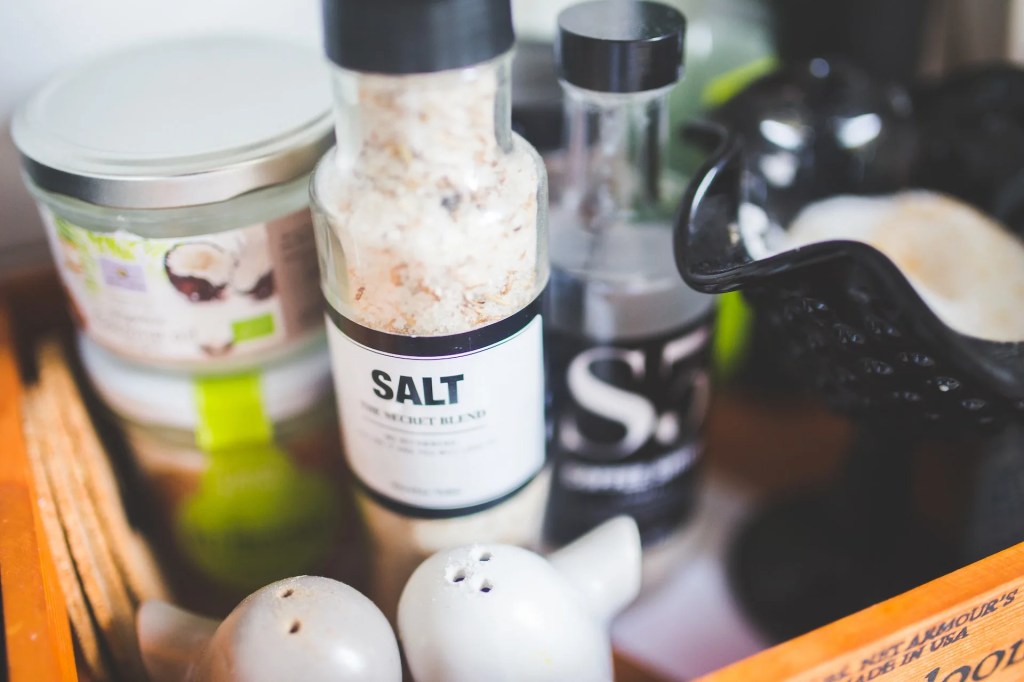Your cart is currently empty!
Salt & Babies

While sodium is essential for human nutrition, babies get all they need from breastmilk, formula, fruits, and veggies.
Sodium plays a critical role in various bodily functions, including maintaining proper fluid balance, transmitting nerve signals, and supporting muscle contractions. However, babies typically obtain all the sodium they need from sources like breast milk, formula, and whole foods.
Pediatricians recommend refraining from adding salt to your baby’s food during their first 12 months. After age 1, small amounts of salt may be introduced.
Risks of Too Much Salt:
- Kidney Damage: Adding salt to your baby’s food in an attempt to enhance flavor can inadvertently introduce health risks. Babies, with their developing kidneys, struggle to process excess salt efficiently, potentially leading to kidney damage.¹
- Taste Preferences: Too much salty food in the first 1,000 days can also lead to unhealthy food preferences later in life. Once the child is older, they may opt for processed foods, which tend to be high in salt and low in nutrients, over fruits and vegetables.² ³
- High Blood Pressure: Research suggests that the blood-pressure-raising effect of salt may be stronger in babies than it is in adults.3 As a result, babies fed a sodium-rich diet tend to have higher blood pressure levels during childhood and adolescence, which increases their risk of heart disease later in life.⁴ ⁵
In extreme cases, very high intakes of salt can require emergency medical care. However, this is rare and usually results from a baby getting into a jar of salt, not from parents adding it to food.
Sodium Needs
- 0-6 Months Old: Young babies get all the sodium they need through breast milk and formula.
- 7–12 Months: Their sodium needs are met through breast milk, formula, fruits, and veggies.
- 1-3 Years: Toddlers only need an average of 2 grams of sodium per day, the equivalent of about ½ a tsp of salt.⁶
Recognizing Excessive Sodium Intake
It’s important to recognize the signs of excessive salt consumption in your baby. If your baby consumes a meal that’s too salty, they may appear thirstier than usual. Usually, the effects of a high-sodium diet aren’t immediately noticeable but develop over time. In extremely rare cases, excessive salt intake can lead to hypernatremia, a condition characterized by an excess of sodium in the blood.⁷ This condition can cause irritability and lethargy. Contact your pediatrician right away if you suspect your baby has consumed too much salt.
Ways to Limit Salt Intake
- Choose baby purees with no added salt
- Do not add salt to homemade purees
- Check the labels of canned foods and look for “no added salt”
- Avoid restaurant foods and frozen meals for babies, which tend to be higher in salt⁸
- Add salt near the end of cooking family meals, so you can set aside an unsalted portion for baby
- Rinsing canned foods like beans and peas can also reduce their sodium content¹⁰
- Pay attention to the sodium content in commonly purchased foods like bread, cereal, and sauces.
Sources
- Emmerik NE, de Jong F, van Elburg RM. Dietary Intake of Sodium during Infancy and the Cardiovascular Consequences Later in Life: A Scoping Review. Ann Nutr Metab. 2020;76(2):114-121. doi: 10.1159/000507354. Epub 2020 Apr 7. PMID: 32259824.
- Liem DG. Infants’ and Children’s Salt Taste Perception and Liking: A Review. Nutrients. 2017 Sep 13;9(9):1011. doi: 10.3390/nu9091011. PMID: 28902163; PMCID: PMC5622771.
- D’Auria E, Borsani B, Pendezza E, Bosetti A, Paradiso L, Zuccotti GV, Verduci E. Complementary Feeding: Pitfalls for Health Outcomes. Int J Environ Res Public Health. 2020 Oct 29;17(21):7931. doi: 10.3390/ijerph17217931. PMID: 33137971; PMCID: PMC7662522.
- Genovesi S, Giussani M, Orlando A, Orgiu F, Parati G. Salt and Sugar: Two Enemies of Healthy Blood Pressure in Children. Nutrients. 2021 Feb 22;13(2):697. doi: 10.3390/nu13020697. PMID: 33671538; PMCID: PMC7927006.
- Shi L, Krupp D, Remer T. Salt, fruit and vegetable consumption and blood pressure development: a longitudinal investigation in healthy children. Br J Nutr. 2014 Feb;111(4):662-71. doi: 10.1017/S0007114513002961. Epub 2013 Sep 5. PMID: 24326147.
- Virginia A. Stallings, Meghan Harrison, & Maria Oria (n.d.). Sodium: Dietary Reference Intakes for Toxicity. The National Academies Press. https://nap.nationalacademies.org/read/25353/chapter/14
- Waseem A, Nafees M, Murtaza G, Sajjad A, Mehmood Z, Siddiqi AR. Salt Toxicity (Sodium Intake): A Serious Threat to Infants and Children of Pakistan. Iran J Public Health. 2014 Sep;43(9):1204-11. PMID: 26175974; PMCID: PMC4500422.
- D’Auria E, Bergamini M, Staiano A, Banderali G, Pendezza E, Penagini F, Zuccotti GV, Peroni DG; Italian Society of Pediatrics. Baby-led weaning: what a systematic review of the literature adds on. Ital J Pediatr. 2018 May 3;44(1):49. doi: 10.1186/s13052-018-0487-8. PMID: 29724233; PMCID: PMC5934812.
- Fewtrell M, Bronsky J, Campoy C, Domellöf M, Embleton N, Fidler Mis N, Hojsak I, Hulst JM, Indrio F, Lapillonne A, Molgaard C. Complementary Feeding: A Position Paper by the European Society for Paediatric Gastroenterology, Hepatology, and Nutrition (ESPGHAN) Committee on Nutrition. J Pediatr Gastroenterol Nutr. 2017 Jan;64(1):119-132. doi: 8.1097/MPG.0000000000001454. PMID: 28027215.
- Haytowitz, D.B. “Effect of Draining and Rinsing on the Sodium and Water Soluble Vitamin Content of Canned Vegetables.” USDA, www.ars.usda.gov/ARSUserFiles/80400525/articles/eb11_drainedveg.pdf.
- Gowrishankar M, Blair B, Rieder MJ. Dietary intake of sodium by children: Why it matters. Paediatr Child Health. 2020 Feb;25(1):47-61. doi: 10.1093/pch/pxz153. Epub 2020 Feb 6. PMID: 32042243; PMCID: PMC7002818.










